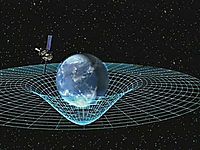
Photo from wikipedia
In the cancer treatment using the proton beam, in vivo dose verification is one of the most important in utilizing the characteristics of the proton beam delivering high dose to… Click to show full abstract
In the cancer treatment using the proton beam, in vivo dose verification is one of the most important in utilizing the characteristics of the proton beam delivering high dose to the target, called as Bragg peak. Measuring the prompt gammas generated along the beam track with the proton-induced nuclear interaction is one of the most preferred method. However, the detection efficiency is very low with their high energy (2–10 MeV), especially measuring the distal dose edge location is currently challengeable [1] . In the current study, the relationship between the time-structure of the prompt gamma and proton dose distribution was evaluated, and the feasibility of in vivo range verification by measuring the prompt gamma time-structure was evaluated with Geant4 Monte Carlo (MC) simulation. A detection system selectively measuring prompt gammas on 90 deg with tungsten collimators was employed [2] , and the detector measured the time-structure depending on the measurement position along the beam direction. The water phantom and lung phantom representing the homogeneous and the heterogeneous were used, respectively. In the current MC results, the time-structures of the prompt gammas in the both of the water phantom and lung phantom were clearly discriminated according to the detector position within 2 cm. Moreover, the depth resolution of less than 5 mm was achieved in the water phantom. It was observed that the patterns of the time-structures generated by the range modulation wheel step could potentially predict the beam current and the dose distribution. This study verified the feasibility of the in vivo dose verification by measuring the time structure of the prompt gammas. For the clinical use of this method, various background reduction techniques such as time-of-flight and pulse shape discrimination would be required.
Journal Title: Physica Medica
Year Published: 2017
Link to full text (if available)
Share on Social Media: Sign Up to like & get
recommendations!